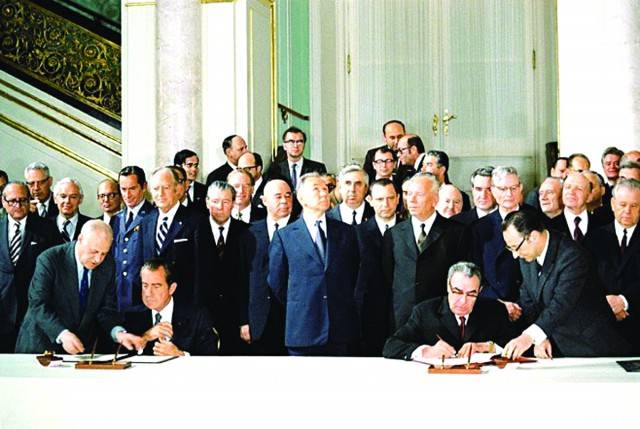
The Moscow Summit of 1972 was a summit meeting between President Richard M. Nixon of the United States and General Secretary Leonid Brezhnev of the Communist Party of the Soviet Union. It was held May 22–30, 1972. It featured the signing of the Anti-Ballistic Missile (ABM) Treaty, the first Strategic Arms Limitation Treaty (SALT I), and the U.S.–Soviet Incidents at Sea agreement. The summit is considered one of the hallmarks of the détente at the time between the two Cold War antagonists.
Starting in November 1969 negotiations began between the United States and the Soviet Union on limiting Anti- Ballistic Missile Systems. The USSR had deployed systems around a number of strategic missile sites. Those negotiations were soon widened to include all aspects of Strategic Weapons The negotiations had many ups and downs finally in May of 1971 the two side came close to an agreement. At the end of May 1972 President Nixon after a successful summit in China traveled to Moscow to meet Soviet Leader Brezhnev and they were able to finalize the agreement. The two leaders signed both an Anti-Ballistic Missile Treaty that limited both sides to the number of sites to two sites protected by ABM’s as well as limiting the number of ballistic missiles both sides had to the numbers they currently had in place. Starting in November 1969 negotiations began between the United States and the Soviet Union on limiting Anti-Ballistic Missile Systems. The USSR had deployed systems around a number of strategic missile sites. Those negotiations were soon widened to include all aspects of Strategic Weapons The negotiations had many ups and downs finally in May of 1971 the two side came close to an agreement. At the end of May 1972 President Nixon after a successful summit in China traveled to Moscow to meet Soviet Leader Brezhnev and they were able to finalize the agreement. The two leaders signed both an Anti-Ballistic Missile Treaty that limited both sides to the number of sites to two sites protected by ABM’s as well as limiting the number of ballistic missiles both sides had to the numbers they currently had in place.

Starting in November 1969 negotiations began between the United States and the Soviet Union on limiting Anti- Ballistic Missile Systems. The USSR had deployed systems around a number of strategic missile sites. Those negotiations were soon widened to include all aspects of Strategic Weapons The negotiations had many ups and downs finally in May of 1971 the two side came close to an agreement. At the end of May 1972 President Nixon after a successful summit in China traveled to Moscow to meet Soviet Leader Brezhnev and they were able to finalize the agreement. The two leaders signed both an Anti-Ballistic Missile Treaty that limited both sides to the number of sites to two sites protected by ABM’s as well as limiting the number of ballistic missiles both sides had to the numbers they currently had in place. Starting in November 1969 negotiations began between the United States and the Soviet Union on limiting Anti-Ballistic Missile Systems. The USSR had deployed systems around a number of strategic missile sites. Those negotiations were soon widened to include all aspects of Strategic Weapons The negotiations had many ups and downs finally in May of 1971 the two side came close to an agreement. At the end of May 1972 President Nixon after a successful summit in China traveled to Moscow to meet Soviet Leader Brezhnev and they were able to finalize the agreement. The two leaders signed both an Anti-Ballistic Missile Treaty that limited both sides to the number of sites to two sites protected by ABM’s as well as limiting the number of ballistic missiles both sides had to the numbers they currently had in place.


